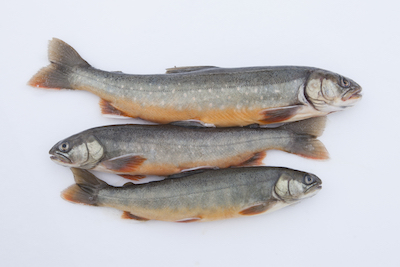About Arctic Charr – An Introduction

The Arctic Charr (Salvelinus alpinus) is one of 5 fish species that are classified as charr. Charr species are difficult for many anglers to differentiate from trout and even salmon.
In fact, many charr are considered other species by most seasoned anglers.
Contributing to this confusion is that the 5 species are so greatly different in coloration that many are considered to be species or subspecies. In fact, several Charr have common names with the name trout in them further confusing matters such as brook trout, bull trout and the very popular lake trout.
The same species is also often referred to as 2 separate species. The anadromous form and the nonanadromous forms. This is just a confusion over terminology.
What’s the difference between anadromous and nonanadromous charr?
The anadromous form is a charr that migrates to the sea and the nonanadromous is a charr that’s landlocked, living in freshwater year round for life. Or simply put, anadromous means seagoing.
The ocean going (anadromous) Arctic Charr is larger than its landlocked (nonanadromous) charr, which is expected. This is largely due to the fact that there’s more food in the ocean than there is in lakes and river watersheds.
The Arctic Charr is found everywhere that the sea-run charr exists but also occurs in smaller numbers much farther to the south.
The Arctic Charr is known by 15 different names
Adding to the confusion is the naming convention of the Charr species. The Arctic Charr is known by over 15 different names. The ocean going Arctic Char is most often called the char, red charr or arctic charr.
The Inuit have many names for the Arctic charr: iqalugaq, iqaluk, ilkalupik, ivisaaruq, kisuajuq, majuqtuq, nutiliarjuk, situajuq, situliqtuq, tisuajuq.
And, being a fish found in Europe and asia, it’s also called fjeldørred, omble chevalier, saibling, eqaluk, bleikja, iwana, arktisk roye, goletz and röding.
The landlocked Arctic Charr is known by blueback charr, blueback trout, Sunapee trout, golden trout (Sunapee), Quebec red.
For the table
The Arctic Charr has a mild flavor and cooks up quickly, having a good taste and texture. It is generally accepted that its taste is a mix between salmon and trout. It’s also a great source of omega-3, making t a good healthy choice.
As far as cooking is concerned, it’s just as flexible as Salmon. The Arctic Charr can be grilled, steamed, broiled, poached or blackened.
Artic Charr preferred food
The Arctic Char prefers insects, mollusks and small fish. Ninespine sticklebacks are important forage in some places.
The charr often doesn’t eat in the winter when its metabolic rate slows in tune with a cooling environment, entering a semi sleeping state.
During this time, it lives on the fat it’s accumulated during the summer. As such, growth is limited during the cold months and greatest when at sea.



